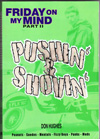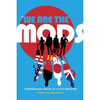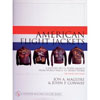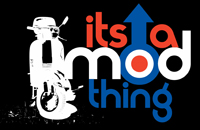Mod Books

Pushin & Shovin - Sequel to 'Friday On My Mind' Written by Don Hughes
You can buy this book here
The second part of Don Hughes' mod-related life story reviewed by Paul 'Smiler' Anderson.
It's almost a year to the day since I wrote a review of Don’s last book Friday On My Mind and here I am writing a review of the sequel. When Don handed the snot green covered follow up entitled Pushin' & Shovin' I was genuinely excited. You see I'd found the first book so enthralling as Don told of his years growing up and his journey through the highs and the lows of Mod life in the 60s. The book ended with the summer of 1967 and the Hippy culture devouring his beloved way of life forever. Or had it?
Pushin' & Shovin' takes up where the last book ended. The opening chapter sees Don trying to navigate his way through life whilst mourning the love of his cherished mod culture. The scooter gangs have long gone, and with them his old friends have faded to a whiter shade of pale. In an attempt to move on and fit in with the new world Don decides to move away from his family home. Settling down might just be what the doctor ordered, but inside he feels tormented and struggles to get to grips with life outside of mod. Steve Ellis and his band Love Affair provide a temporary relief away from the flower power monotony but seems only to inspire him to buy yet another scooter.
Soon he is riding around on a GS160, and justifies the purchase to himself by regarding it as a mere means of transport. Don then decides to take his relationship to his girlfriend Barbara far more seriously. Surely ideas of marriage and settling down would provide the ideal distraction from these sentimental cravings?
Nothing surprises the reader when the lure of a shiny diamond engagement ring for his ;soon to be betrothed; is suddenly hijacked by the lure of one last fling on a shiny Eddie Grimstead Vespa SS180. Sadly the pills to accompany these sentimental indulgences were not the leapers and bombers of yesteryear, they were anti-depressants. Otis had died, Radio Caroline was no more, skinheads had become the new ;Sawdust Caesars; and the hippy revolution dominated the music scene. The search for the elusive Holy Grail that might prove to be the new Mod trend had proved fruitless.
Wedding bells ring and Don tries to settle down. He must accept his fate in a bleak musical landscape of prog rock and recycled soul. A new decade is dawning, casting his teenage dreams to the scrapheap as the arrival of the 1970s sign their death warrant.
As the new era begins we see Don taking his first real political stance. As the General Election of June 1970 approaches, Harold Wilson's Labour government wage war on pirate radio. Don finds himself working for none other than Radio Caroline owner Ronan O'Rahilly in a bid to get the Tories elected. Soon enough he sadly finds that Ted Heath is just another part of the establishment as his hopes of decent music stations being legalised disappear. The realisation that most politicians disappoint you eventually is a lesson that will remain with young Hughes forever.
His pursuit of 'the next big thing' continues and Don finds himself flirting with folk music on the live scene whilst collecting old singles. Realising that there is a demand for these forgotten vinyl gems, he sets about making up sales lists of old rock & roll and R&B to sell. Still battling depression, Don tries hard to control his home life by settling down in a new home in West London and becoming a father. Distractions continue to hinder this in the form of an affair with a West Indian girl and the emerging glam and pub rock scenes. Night times see him trawling through the live music venues such as the Hope & Anchor in Islington in his quest for the impossible dream. He's then given the incentive of being sent a hundred dollars a month to be a UK music scene correspondent for an American music magazine and this only fuels the passion. One evening in March 1976 it seems his search has come to an end when he accidentally stumbles across an early Sex Pistols gig at the Nashville Rooms in Islington. Adventures then continue in the new punk underworld including early 100 Club gigs, a run in with a certain Sid Vicious, the Roxy Club gigs, and the Bill Grundy incident. Battling against the cheese cloth and flares hell that his wife wishes to bestow on him, Don finds himself in freefall and his marriage disintergrates.
The 1980s find the author spiralling into an alcohol fuelled oblivion. Punk had died a death and proved to be a let down. And now with Thatcher's government reigning at number 10, rising interest rates and inflation sees Don's record business collapse. The Swan pub in Hanworth becomes his chosen refuge, a place to hold court as the drink flows. Touching 30, Don finds himself on the periphery of the new mod revival surrounded by those too young to remember the original dream. On a positive note it inspires him to check out live bands once more such as The Crooks. He trawls his memory and puts them into a mod fanzine entitled 'I Like It Like That'. Although this proves a success, the profits are soon spent over the bar as he descends further into an intoxicant wasteland.
The last two chapters of the book are intense and brutally honest as Don describes the chaos and carnage, both physical and emotional, that he leaves in his wake. Although he does find love, marriage and parenthood once more with a girl he truly loves, destruction is never far behind. Thankfully the Grim Reaper is cast aside when Don finally seeks help and guidance courtesy of Alcoholics Anonymous.
Personally I found Pushin' & Shovin' even more enjoyable than Friday On My Mind. This is probably because the era's that are talked of are familiar to me. I certainly remember the early days of glam, the punk revolution and the mod revival. I could find solace in my memories of fizzy boys and punks. Pub life has also featured heavily in my own life but thankfully not to the extremes of Don's chosen path, although I am relieved he eventually sought help. He has lived an extraordinary life and luckily lived to tell the tale, there is no doubting that Don can tell an interesting story as his books are highly engaging and entertaining. I would like to think that he has at last laid his demons to rest and that his search for the elusive mod 'nirvana' has come to an end. He may never have discovered a substitute for those crazy days of 1965 but thankfully they are still locked in his memory. And we as readers are lucky that he has chosen to share those precious treasures with us.

Excerpt taken from: "We Are The Mods" - A Transnational History Of A Youth Subculture. Written by Christine Jacqueline Feldman
You can buy this book here
"You'll hear my children say, all or nothing for me." - The Small Faces, 1966
"I am not a number, I am a free man." - The Prisoner TV show, 1967
After a day reading about English Mod culture in the British library, I went to meet Eddie Piller at an East End pub near his office. I was pleased he had agreed to an interview, because I had come across issues of his former fanzine, Extraordinary Sensations, at the library. He had been part of the London Mod Revival in the late 70s, his mother ran the Small Faces Fanclub in the mid-60s, and he DJed in many parts of the world - now occasionally for the BBC. I found Eddie at a typical pub - still quiet, since it was only four o'clock. After I introduced myself, we talked for over an hour about "Mod and the world." He told me about what he had learned from his parents about Mod, the violence between Mods and Skinheads in the late 70s, and the difference between "Mod" and the "Mod Scene." Later, upon reading the initial manuscript of this publication, Eddie would tell me he thought my interpretation of the interview "too literal." Nonetheless, the excerpts high-lighted here offer readers a solid testimonial as to how the subculture may have come to be.
As he spoke, Eddie's distinctive, gravely voice and Cockney accent expressed varying emotions. At one point, he derided what he saw as near-fascistic attitudes in the current British Mod scene. He touched my hand reassuringly and said, "Anyway, I've lost me temper," and then continued. Involved with Mod - one way or another - since age fourteen, Eddie had clearly thought about this topic. I finally came to my main question: If Mod was initially about working-class kids in London searching for something better, why had the term also attached itself to the Beatles and the "Swinging London" phenomenon? I feared this question because some Mods vehemently separated the two: the Beatles and Swinging London were "60s Pop," and the Rhythm and Blues/Soul, working-class underground was "Mod." However, Eddie's not so black-and-white answer surprised me.
Eddie emphasized several important points. The influence of Jazz and advertising were linking to Americanization. In their attraction to both this music genre and American advertising, working-class kids found both figurative (the free-sounding rhythms of Jazz) and literal (better work) means of escape.
I was intrigued by Eddie's story of how Mod evolved from an underground scene to a full-blown, media saturated phenomenon. Suddenly it included bands like the Rolling Stones and the Who (managed initially by Oldham and Meaden, respectively) and designers Quant and Stephen. It suggested that an essential part of Mod, even if not present from day one, was a sense of entrepreneurship. Since working-class kids were trying to find a way "out" of factory jobs, why not "sell" what they knew best and had the most fun with? Young men like Oldham and Meaden reconfigured a working life that was creative and fulfilling financially and personally.

Excerpt taken "American Flight Jackets" - A History of U.S. Flyers' Jackets From World War II To Dessert Storm. Authors Jon A. Maguire & John P. Conway.
This is a truly exceptional publication with excellent photographs throughout.
You can buy this book here
Perhaps no other garment has been so readily associated with a profession since the days of knights in armor, as the flight jacket. The first aviators adopted leather as their material of choice because of its durability, warmth, and, of course, good looks! Although cloth jackets have always been around and used extensively, the leather jacket immediately comes to mind when one hears "flight jacket." Perhaps the pinnacle of leather jackets was reached with the A-2 flight jacket made famous by U.S. Army airmen of World War II. World War II veterans speak of these garments with reverence, and the fact that numerous examples exist after fifty years is a testimony to their durability. These jackets also made a wonderful canvas for self expression. American soldiers have always been individuals - especially airmen! A-2 jackets were painted with everything from pin-up girls to airplanes. They were also decorated with unit patches and nicknames. U.S. Navy and Marine Corp flyers have equal affection for the G-1 jacket. Although seldom encountered with paintings, G-1s are often adorned with numerous patches.
From the earliest days of flight one of the first challenges faced by airmen was that of keeping warm at altitude. For this reason flight jackets have been a major part of aviation from the start. The problem of keeping warm reached its peak in the early days of World War II when large numbers of airmen went aloft in unpressurized, unheated bombers. These missions were flown at altitudes over 20,000 feet where temperatures could reach 60 degrees below zero. This, coupled with open waist windows and drafty nose turrets, made conditions miserable. The first high altitude gear was made of shearling. The classic shearling jacket of that period is the B-3. As the war progressed, electric suits were developed and less expensive, more easilly supplied, cloth jackets began to replace the leather gear. The B-10 and B-15 were widely used and well liked by American airmen. These jackets are also found with paintings, although not as commonly as A-2s. In the years following World War II synthetic fabrics were developed. Fire resistant agents became available, and leather faded in utility, but not in popularity. The Navy kept the G-1 in its inventory and, in recent years, the Air Force has reissued the A-2.
Through contemporary and modern photographs, this chapter attempts to show the progression of American flight jackets from the privately purchased coats of World War I to the high-tech garments worn in Dessert Storm.




